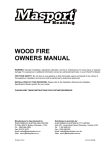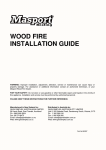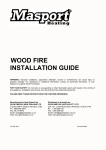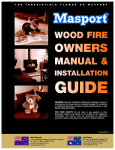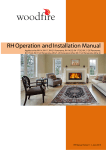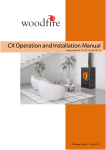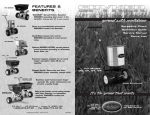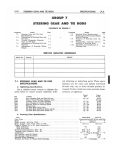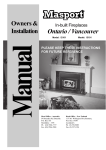Download Masport BELVEDERE Operating instructions
Transcript
WOOD FIRE OWNERS MANUAL WARNING: Improper installation, adjustment, alteration, service or maintenance can cause injury or property damage. For assistance or additional information consult an authorized technician, or your Masport Wood Fire Dealer. FOR YOUR SAFETY: Do not store or use gasoline or other flammable vapors and liquids in the vicinity of this appliance. Installation and service must be performed by authorized personnel. PLEASE KEEP THESE INSTRUCTIONS FOR FURTHER REFERENCE. Manufactured in New Zealand by: GLEN DIMPLEX AUSTRALASIA LIMITED 38 Harris Road, East Tamaki, Auckland Ph: 0800 666 2824 Fax: 09 274 8472 Email: [email protected] Web: www.glendimplex.co.nz Distributed in Australia by: GLEN DIMPLEX AUSTRALIA PTY LIMITED Unit 2, 205 Abbotts Road, Dandenong South, Victoria 3175 Ph: 1 300 566 816 Fax: 1 800 058 900 Email: [email protected] Web: www.glendimplex.com.au Part No.593286 CONTENTS OF LOOSE PARTS BAG (Some freestanding models) (Note: You may not need all these parts for your installation) Part No. Quantity 522117 10 M6 Hexagon Nut 523031 4 M6 Flat Washer Where Used 4 - Pedestal front to pedestal sides 4 - Firebox to pedestal 2 - ‘L’ Brackets to pedestal 4 - Firebox to pedestal 521060 4 M6 x 35mm Hex. Set Screw 4 - Firebox to pedestal 521075 6 M6 x 12mm Hex. Set Screw 521605 4 521635 4 522402 2 521637 2 Self Threading Screw — 25mm long 2 - Seismic restraint bar to pedestal 986413 2 ‘L’ Bracket 2 - Sides or rear of pedestal 6mm Description 4 - Pedestal front to pedestal sides 2 - ‘L’ Brackets to pedestal 4 - Heat shield to top of pedestal Self Threading Screw — 12mm long, zinc plated finish Self Threading Screw 4 - Pedestal rear panel to pedestal — 12mm long, black finish ‘C’ Nut (Spire # SNU 0537) 12mm 2 - Seismic restraint bar to pedestal 25mm 35mm 2 CONTENTS OPERATING INSTRUCTIONS FOR ALL MODELS Page CONTENTS OF LOOSE PARTS BAG 2 INTRODUCTION 4 BASIC INFORMATION 5 LIGHTING UP 6 OPERATING HINTS 7 SAFETY 8 9,10,11 MAINTENANCE BEFORE EACH HEATING SEASON 12 THIS BOOK CONTAINS IMPORTANT INFORMATION. PLEASE KEEP IT IN A SAFE PLACE FOR FUTURE REFERENCE. 3 INTRODUCTION In the interests of your safety, most building regulatory Authorities in Australia and New Zealand require any wood fire installation to comply with Installation Standard AS/NZS 2918. They may also have local requirements in addition to those in the Standard. Check with your local Building Authority before commencing installation, to find if you will require a Permit and whether there are extra requirements. All MASPORT Wood fires have been tested to ensure that they will meet the appropriate safety Standard requirements if the instructions in this book are followed. As the safety and emissions performance can be affected by altering the appliance, no modifications are allowed without written permission from the manufacturer. Wood fire models covered by this manual have been tested to demonstrate compliance with current general emission requirements in Australia and New Zealand, but some areas have stricter limits. Only some of the models meet those limits, so check before purchasing or installing a particular model. In areas covered by stricter emission regulations:(I) If a water-heating device is permitted, it must be factory fitted or be a Masport accessory retrofitted strictly in accordance with the instructions supplied by Masport. (II) Coal must not be used as a fuel. (III) Wood fuel must have a moisture content of less than 25%. WE RECOMMEND TH AT THE INSTALL ATION OF YOUR M ASPORT WOODFIRE BE CARRIED OUT BY A QUALIFIED SPECIALIST INSTALLER. IF ANY ELECTRICAL WORK IS REQUIRED, IT MUST BE CARRIED OUT BY A LICENSED ELECTRICIAN. WARNING: THE APPLIANCE AND FLUE SYSTEM MUST BE INSTALLED IN ACCORDANCE WITH AS/NZS 2918 AND THE APPROPRIATE REQUIREMENTS OF THE RELEVANT BUILDING CODE OR CODES. WARNING: APPLIANCES INSTALLED IN ACCORDANCE WITH THIS STANDARD SHALL COMPLY WITH THE REQUIREMENTS OF AS/NZS 4013 WHERE REQUIRED BY THE REGULATORY AUTHORITY, I.E. THE APPLIANCE SHALL BE IDENTIFIABLE BY A COMPLIANCE PLATE WITH THE MARKING ‘TESTED TO AS/NZS 4013’. ANY MODIFICATION OF THE APPLIANCE THAT HAS NOT BEEN APPROVED IN WRITNG BY THE TESTING AUTHORITY IS CONSIDERED TO BE IN BREACH OF THE APPROVAL GRANTED FOR COMPLIANCE WITH AS/NZS 4013. WARNING FOR APPLIANCES WITH WATER HEATING DEVICES: DO NOT CONNECT TO AN UNVENTED HOT WATER SYSTEM. INSTALL IN ACCORDANCE WITH AS 3500.4.1 OR NZS 4603 AND THE APPROPRIATE REQUIREMENTS OF THE RELEVANT BUILDING CODE OR CODES. IN SOME REGIONS POWER POINTS ARE NOT PERMISSIBLE WITHIN THE FLOOR PROTECTOR AREA, PLEASE CHECK WITH YOUR LOCAL AUTHORITY. PLEASE ENSURE THAT ONLY COMPONENTS APPROVED BY MASPORT ARE USED FOR THE INSTALLATION, as substitutes may adversely affect performance and might nullify compliance with the requirements of AS/NZS 2918. CAUTION: MIXING OF APPLIANCE OR FLUE SYSTEM COMPONENTS FROM DIFFERENT SOURCES OR MODIFYING THE DIMENSIONAL SPECIFICATION OF COMPONENTS MAY RESULT IN HAZARDOUS CONDITIONS. WHERE SUCH ACTION IS CONSIDERED, THE MANUFACTURER SHOULD BE CONSULTED IN THE FIRST INSTANCE. CAUTION: CRACKED AND BROKEN COMPONENTS, e.g. GLASS PANELS, MAY RENDER THE INSTALLATION UNSAFE. TO AVOID THE RISK OF ELECTRIC SHOCK OR CONTACT WITH MOVING PARTS, ONLY THE MANUFACTURER, THE MANUFACTURER’S SERVICE AGENTS OR SIMILARLY QUALIFIED PERSONS SHOULD REMOVE THE BOTTOM PANELS WHICH ALLOW ACCESS TO FANS. 4 OPERATING INSTRUCTIONS — ALL MODELS BASIC INFORMATION DOOR HANDLE Front mounted handles. To open the door:- Rotate the handle upward anti-clockwise to the 1 o’clock position. To close the door:- Push the door toward the fire box, using the handle, and turn the handle clockwise to the 4 or 5 o’clock position. Side mounted handles. To open the door:- Pull the lower part of the handle, forward and upward. To close the door:- Hold the handle up whilst closing the door. Push the handle down to the vertical position to lock the door. HEAT OUTPUT CONTROL This control has a sliding action. It is clearly marked with a wedge shaped symbol. Slide the control in the direction of the wide end of the wedge (to the right) to increase the heat output and toward the narrow end (to the left) to decrease it. Shutting a high fire down rapidly by starving it of air will result in undesirable emissions. For this reason, Masport wood fires are designed to settle down to lower heat outputs comparatively slowly. Note:- The lever on some models is marked ‘H’ for high fire and ‘L’ for low fire. EXTENDED BURNING Masport Fires will burn for a long period. To achieve this, level the embers and load the fire wood lying front to back. Use large logs and ensure that there are gaps between the fire wood to allow air to reach all the pieces of wood. Open the air inlet fully for 15 to 20 minutes. When the fire is burning fiercely, reduce the air intake in stages to the minimum opening. NEVER LET THE FIRE SMOULDER. FAN OPERATION Inbuilt Wood fires should not be operated on maximum heat with very dry softwood, unless the fan is operating. On freestanding woodfires, the optional fan MUST only be operated when the air control on the fire, is set on ‘HIGH’ ESSENTIAL ADVICE Correct installation, the use of only DRY wood and adherence to the following instructions will ensure satisfactory performance. WARNING: MAKE SURE THE MINIMUM HEATER-TO-WALL DISTANCES SHOWN ON THE SPECIFICATION SHEET, ARE ALWAYS MAINTAINED BETWEEN THE HEATER AND ANY HEAT SENSITIVE ITEMS. (FURNITURE, DRAPES, ETC.) WARNING: DO NOT STORE FUEL WITHIN THE HEATER INSTALLATION CLEARANCES. WARNING: DO NOT USE FLAMMABLE LIQUIDS OR AEROSOLS OR PLACE THESE IN THE VICINITY OF THIS APPLIANCE WHEN IT IS OPERATING. WARNING: THIS APPLIANCE MUST NOT BE USED AS AN OPEN FIRE. WARNING: WHEN FITTED WITH A WATER HEATING BOOSTER, THIS APPLIANCE MUST NOT BE CONNECTED TO AN UNVENTED HOT WATER SYSTEM. THIS APPLIANCE MUST BE INSTALLED WITH AN OPEN VENT. THERE MUST BE NO SHUT-OFF OR NONRETURN VALVES IN THE PIPING SYSTEM. REFER TO WATER PIPE INSTALLATION INSTRUCTIONS. 5 LIGHTING UP CAUTION: THIS APPLIANCE SHOULD BE MAINTAINED AND OPERATED AT ALL TIMES IN ACCORDANCE WITH THESE INSTRUCTIONS Slide the heat output control fully to the hot position. Crumple up several double sheets of newspaper and place them in the centre of the firebox. Build a pyramid of thin, dry kindling wood on the paper with some heavier pieces on top. Light the paper at the bottom and leave the door slightly ajar until the kindling has ‘caught’, then latch the door shut firmly. When loading fuel, place the pieces of wood in a front-to-back direction to ensure good air access and the cleanest possible burning Always leave ash to the level of the tops of the floor ribs. WARNING: DO NOT USE FLAMMABLE LIQUIDS OR AEROSOLS TO START OR REKINDLE THE FIRE. WARNING: ALWAYS MOVE THE AIR CONTROL TO THE OPEN POSITION (TO THE RIGHT) BEFORE OPENING THE FIRING DOOR. When the kindling is well alight, open the door slowly and add some larger pieces of wood. Do not throw fuel pieces into the firebox as this may damage the top baffle and the insulating boards or firebricks. Close and latch the door firmly. Move the heat output control away from the maximum position only after the fire is well established. A new wood fire should not be run at higher than half setting beyond the first 30 minutes until it has been used for a total of 8 hours. Once fully ‘run in’, we recommend running at full heat for up to one hour after lighting as this will minimize creosote build-up in the flue. The control can then be set wherever desired. The special high temperature paint on the firebox will emit some smoke as it cures during the first hour or so of running. This is quite normal. CAUTION: THIS APPLIANCE MUST NOT BE OPERATED WITH A CRACKED GLASS. 6 OPERATING HINTS FOR CLEAN BURNING AND BEST EFFICIENCY FUEL: USE ONLY WOOD THAT HAS BEEN AIR DRIED IN A SHELTERED WELL VENTILATED STACK, PREFERABLY FOR AT LEAST 12 MONTHS. If moist fuel must be used, add it only to a really hot fire, mixing it with a large proportion of dry fuel. In Clean Air Zones, only wood may be used as fuel, and it must have a moisture content not greater than 25% (measured on a dry weight basis). • Do not burn driftwood or coloured paper as these can corrode the wood fire and flue. CAUTION: THE USE OF SOME TYPES OF PRESERVATIVE TREATED WOOD AS FUEL CAN BE HAZARDOUS. • Add fuel reasonably often. A large fuel load placed on a dying fire can drop combustion temperatures undesirably. • Avoid large smouldering fires. A small intense fire is more efficient. • Move the heat control to maximum for a minute or so and turn off the air circulating fan (if fitted) before opening the door on a low burning fire. This will clear away any fumes in the firebox. • Always open the door SLOWLY, and close and latch it shut securely again as soon as possible after re-loading. • When loading fuel, place the pieces of wood in a front-to-back direction to ensure good air access and the cleanest possible burning. • Load fuel carefully to avoid damage to the insulating boards, firebricks or top baffle. • If smoke wafts into the room from a fully established fire while the door is open, first check that make-up air can flow freely into the room to replace the air passing up the flue. (See box below). Then check that the flue is not obstructed in any way, particularly by the rain cap being too close to the end of the flue. (See the flue cleaning requirements in the Maintenance section, page 9). If these checks do not uncover the fault, add an extra length of flue (bracing it, if necessary) to counteract the down draught effects caused by roof shape, nearby buildings, hills or trees. • Switch off the circulating fan (if fitted) when the fire is burning at low heat outputs. • Adjust the door to eliminate any minor leakage. (See MAINTENANCE - page 9). Serious leakage will require a new door seal. REMEMBER, FOR THE FIRE TO DRAW PROPERLY, AIR MUST BE ABLE TO ENTER THE ROOM WHERE YOUR WOODFIRE IS INSTALLED. YOU MAY HAVE TO LEAVE A DOOR SLIGHTLY OPEN AND PERHAPS A WINDOW ELSEWHERE IN THE HOUSE IF YOUR HOME IS OF MODERN AIRTIGHT CONSTRUCTION. THIS IS PARTICULARLY IMPORTANT IF AN AIR EXTRACTION FAN IS OPERATING SOMEW HERE IN THE HOUSE. LEAVING THE ROOM DOOR OPEN WILL HELP SPREAD WARMTH THROUGH THE REST OF YOUR HOME. 7 SAFETY • Always keep children well away from the wood fire when it is alight. • The appliance is not intended for use by young children, or infirm persons, without supervision. • Supervise young children to ensure they do not play with the appliance. • If the supply cord is damaged, it must be replaced by the manufacturer, its service agent or a suitably qualified person in order to avoid electrical hazard. • Ensure that the electrical plug is accessible after installation. The heater must not be located immediately below an electrical socket. • Do not put furniture, clothing, firewood, or other combustibles near the wood fire. The minimum safe distance is 420mm from the sides and 1 metre from the front. • • Do not leave the fire unattended with the door open. Fires can be caused accidentally, by wrapping seemingly cold ashes in paper. It is much safer to place ashes outside in a metal container with a close fitting lid. • If a fire is burning up inside the flue, slide the heat output control to the low heat position (to the left) and call the Fire Service. DO NOT OPEN THE WOODFIRE DOOR. • If you have had a flue fire, inspect your flue for damage before lighting another fire. • Do not modify your wood fire in any way without obtaining written permission from the Manufacturer. CAUTION. IF THE GLASS IS CRACKED OR BROKEN, THIS APPLIANCE MUST NOT BE USED. THE GLASS SHOULD BE REPLACED ONLY WITH A GENUINE CERAMIC GLASS REPLACEMENT PART, AVAILABLE FROM YOUR MASPORT DEALER. 8 MAINTENANCE ASH REMOVAL This should be necessary only very occasionally. Simply shovel out any excess, always leaving a bed of ash to the tops of the ribs on the bottom of the firebox. Place the removed ashes in a noncombustible container with a tightly fitting lid, and move the container outdoors immediately to a place clear of combustible materials. CLEANING THE GLASS A good hot fire will burn away any deposits left from a long slow burn. If desired, a NONCAUSTIC oven cleaner can be used. CLEANING THE CABINET OR FASCIA A damp rag with a touch of household detergent is sufficient to maintain the finish. ADJUSTING THE DOOR LATCH If the handle is front mounted, the latch can be adjusted to overcome settling of the door gasket by transferring a washer to the outside of the door catch spindle. If the handle is side mounted, the latch is adjusted by rotating the door catch peg. First undo the lock-nut on the inside of the peg, then rotate the peg to the position where the cam portion gives the right locking pressure. Hold the peg in this position, re-tighten the lock nut. The hinge on all models can also be adjusted inward if necessary. Move it in about a millimetre at top and bottom to maintain an even gasket pressure. AIR SLIDE If the air slide does not move freely, apply a small amount of heat resistant Masport air slide lubricant, Part No 794113. CLEANING INSIDE If you wish to clean the flue or clear away creosote debris, the internal components can be removed easily (See below). We recommend that you check the condition of all internal components at least once a season to make sure they are still serviceable. SECONDARY AIR TUBE REMOVAL The tube will have either one or two removable angle pins to prevent it from moving endways and falling out. If there is one removable pin, one end of the tube will have a welded-on locating pin. To remove the tube, simply withdraw the angle pin(s) from the tube, move the tube sideways until one end can be swung down from its locating hole in the firebox side casting and then move it sideways in the other direction to disengage it completely from the firebox. W hen re-fitting the tube, ensure that the small air holes will discharge generally toward the lower front of the firebox, rotating the tube until the welded-on locating pin (or the angle pin) will engage in the slot in the cast iron firebox side casting to maintain the correct angular position of the tube. Replace the angle pin at the other end of the tube. NOTE:In some fires, the air tube is secured to the left hand side of the fire box with a “R” Clip. Remove the “R” Clip and move the tube to the right, remove the tube from the left hand side of the fire box first. 9 FIREBOX TOP BAFFLE. The special top baffle material operates at very high temperature to ensure clean burning. Take care not to knock and damage it. For flue cleaning or baffle replacement the secondary air tube must first be removed as described above. When replacing the baffle, ensure that it is sitting on top of the supporting shelf at each end and that it is pushed right to the back until the front corners drop behind the small retainer ribs on the shelves. Re-fit the secondary air tube. NOTE:Some fires are equipped with steel baffles. FIREBOX LINERS While the insulating boards or firebricks are durable, they will eventually require replacement. A cracked liner does not require replacing unless it will no longer stay in position in the firebox. All Masport models have either fire-bricks, or insulating board to line the firebox. (Some models have insulating boards already fixed in position at the factory). In some models, two of the bricks or boards fit across the back of the firebox wall, and the others fit against the side walls. No force should be required to fit them, and they can be removed, if desired, for flue cleaning. However, they MUST be in place, and in good condition, before lighting the fire. Each brick or board is fitted in the same way. Angle it into position, with its top corner behind the upper retaining lug, then swing it until it is parallel to the wall with its bottom corner behind the lower retaining lug. Lower the brick or board into position. In some models there are two boards at the rear and at each side. In that case, fit the metal retaining channel over the top edges of these pairs of bricks or boards to hold them in line. The wider leg of the channel goes next to the fire box wall. FAN MAINTENANCE Only the manufacturer, its service agent or a similarly qualified person should remove the bottom grille of the Grande Provincial or the ash shelf of the LE4000, LE 5000, LE 7000, Provincial to carry out fan installation, servicing and maintenance. The fan should need little attention other than occasionally (perhaps once a year) removing it to clean dust and lint from the impeller. First unplug the mains lead from the power point. Fans on in-built fires can be accessed by lifting off the ash shelf. Fans on free-standing fires are reached by removing the rear of the pedestal. On free-standing models with internally switched fans, first gently ease off the speed control knob, taking care to pull it off squarely. Remove the four screws (two on the Grandview) which hold the fan box in position. If the fan on the free-stander is internally switched, move it slightly away from the switch end and withdraw it completely. Some fans simply stand on rubber bushes fitted over fixed posts. These simply lift away vertically from the post (remove any shipping nuts first, but do not replace them). Clean the impeller blades carefully by blowing or vacuuming, and reassemble in the reverse order. 10 CLEANING THE FLUE This may be needed about once a year (CHECK YOUR HOUSE FIRE INSURANCE) or more frequently under adverse conditions. Signs of creosote and soot build-up are inadequate draught, smoking when the door is opened and a dull thud when the outside of the flue is tapped. A blocked flue can be cleaned only by sweeping. DO NOT USE CHEMICAL CHIMNEY CLEANERS. FLUE INSPECTION Check regularly that the flue is sound, particularly the metal base of enameled flues. 11 BEFORE EACH HEATING SEASON. To ensure continued safety, check the condition of the following items; the flue system (particularly the flue sections nearest the firebox), the firebox top baffle, the air tube, the firebox liners (bricks and boards) and the door gasket. Replace parts only with genuine MASPORT spares. TESTING YOUR WOOD When the wood fire is thoroughly warmed, place one piece of split wood, about 120mm (6 inches) diameter, parallel to the door on the bed of embers. Keep the air control fully open and close the door. If ignition of the piece of wood is accomplished within 90 seconds from the time it was placed in the fire, the wood is correctly dried. If ignition takes longer, the wood is damp. If the wood hisses and water or vapour escapes from the ends of the wood, the wood is too wet. Do not use this wood in your fire. Large amounts of creosote could be deposited in your flue system, creating potential conditions for a flue fire. 12












